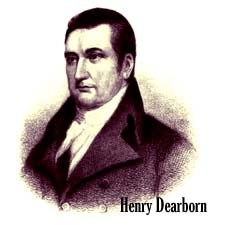| Henry Dearborn |

FRAMERS OF FREEDOM
April 20, 1775 was a momentous day in the life of Henry Dearborn , the young physician from Nottingham, NH. That morning the electrifying news of Lexington and Concord reached the town square. On that same day his wife gave birth to a daughter. A few hours later he marched to Cambridge with the company he had drilled that winter.
Born in 1751 in his grandfather's garrison house at North Hampton, NH Henry Dearborn spent most of his youth in the nearby little town of Epping. Doubtless Henry became interested in military tactics about 1771 during his final year of medical training under the distinguished Dr. Hall Jackson of Portsmouth who, curiously, studied this subject as a hobby.
From Bunker Hill To Quebec
With armed conflict in the Revolution a reality, the new Continental Army at Cambridge hoped to besiege the British in Boston by fortifying Bunker Hill on Charlestown peninsula. Henry Dearborn was among the men of John Stark's regiment who fought at the rail fence during the Battle of Bunker Hill.
Dearborn was also among those asigned to make Canada the 14th colony. The plan was for Gen. Montgomery to inch his way north from Ticonderoga. Meanwhile Col. Benedict Arnold would lead an expedition through uncharted Maine wilderness, meeting Montgomery at Quebec. Arnold's army of 1100 men, including Dearborn, set out for the Kennebec on September 19, 1775.
The march became an horrendous venture. Days of torrential rains turned the march to the first French settlement into a nightmare. Raging floods made river channels difficult to find. Dearborn and his men lost their way. Others broke through ice and slogged through waist-high water in dense swamps. Starvation and death from exposure stalked the badly bruised army, already greatly diminished in size. Several men forced Dearborn to surrender his dog, which they quickly devoured. When they arrived at the first settlement, Dearborn was too ill with pneumonia to continue with the army to Quebec. He recovered sufficiently, however, to join them for the battle on the last day of 1775. In the disaster, Montgomery was killed, Arnold wounded, and the confused army, blinded by snow, lost its way. Dearborn and much of the Army became prisoners.
Victory At Ticonderoga
Paroled in March 1777, Maj. Dearborn was on hand for the retreat from Ticonderoga to Bemis Heights. As men and supplies poured into camp, a strong line of defense was erected for control of the Hudson River. During these preparations, Dearborn was given a special command of the light infantry. The first battle, on September 19th, ended with neither side the victor. But Morgan's riflemen and Dearborn's light infantry almost annihilated Burgoyne's advance guard.
Self-assured for the second engagement, on October 7th, Morgan and Dearborn furiously drove Burgoyne's advance back to the British line. Supported by several regiments and inspired by the timely arrival of the dashing, impetuous Arnold, the Americans took the enemy's strongest redoubt causing the rest of the British line to collapse. This resounding American victory marked the turning point of the American Revolution and brought badly needed French assistance.
Valley Forge To Yorktown
Setting out for the next campaign, Dearborn joined Gen. George Washington's main army at Valley Forge as a lieutenant colonel. In 1778 he was attached to Col. Josehph Cilley's advance battalion and fought valiantly in the orchard at Monmouth. The following summer he joined John Sullivan's expedition against the Indians in New York. Finally, in 1781, he witnessed the surrender of Cornwallis at Yorktown.
After the war, Dearborn left New Hampshire and became a national political figure in the Republican party, serving as secretary of war, as collector of the port of Boston, as major-general in the War of 1812, and as ambassador to Portugal. He retired to his home in Roxbury, Mass., where he died in 1829.
by Helen Hobbs. Originally published in "NH: Years of Revolution," Profiles Publications and the NH Bicentennial Commission, 1976. Reprinted by permission of the publisher. First posted online at SeacoastNH.com in 1997. Revised in 2005.
